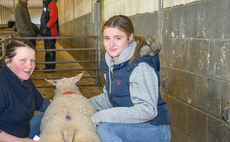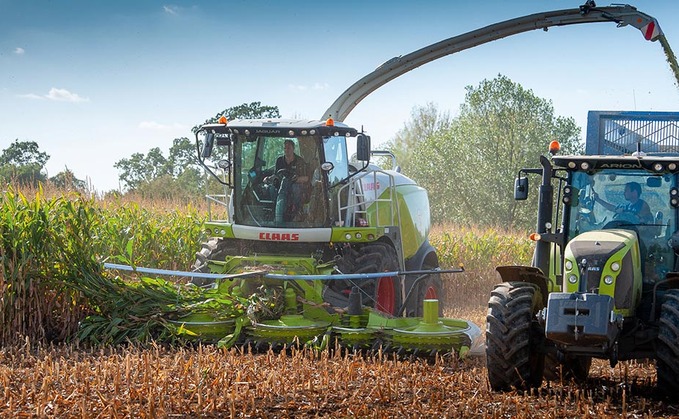
Not one to rest on its laurels when it comes to development, Claas has been busy updating its Jaguar 900 Series self-propelled foragers. James Rickard learns more with a test drive of the new 970.
Though still based on a 25 year old crop flow design, introduced on the Jaguar 800 Series in 1994, you could be forgiven for thinking how much more Claas' engineers can squeeze out of the current Jaguar 900 Series foragers.
However, much like the previous upgrades throughout the years, this latest round brings with it some significant improvements for 2020. These include a more powerful flagship model, a brand new control console and layout, greater adjustment and automation, beefier feeder and cylinder housings, and updated additive dosing and crop sensing technology.
Throughout the Jaguar 900 range, which now spans seven models from 462 to 925hp, all now meet Stage 5 emissions regulations with several models increasing in power (see range overview panel below).
Range overview
Jaguar model | Power (hp) | Power difference from predecessor (hp) | Engine |
990 | New model | 24.2-litre, V12, MAN | |
980 | 24.2-litre, V12, MAN | ||
970 | 16.2-litre, S6, MAN | ||
960 | 15.6-litre, S6, Mercedes | ||
950 | 15.6-litre, S6, Mercedes | ||
940 | 12.8-litre, S6, Mercedes | ||
930 | 12.8-litre, S6, Mercedes |
One model does actually drop a few ponies, the 980. This is to even out the power differences between models, with 60hp between it and the 970 and 75hp between it and the new 990. The latter sees Claas break the 900hp barrier for the first time.
However, the most significant news in the power department comes in the form of the top-selling 970, which has ditched its V8 in favour of a large displacement six-cylinder (see powertrain panel).
As a result of all the updates, the 900 Series moves from its old, type 498 designation to type 502 status. But what do all these updates mean to the now legendary Jag, and are they worth it? To find out, we pointed a new-generation Jaguar 970 at a decent crop of maize and set to.
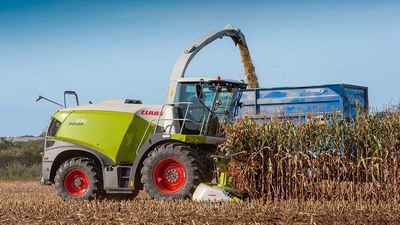
Powertrain
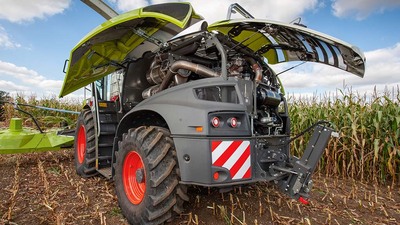
Under the bonnet of the new 970 now resides a brand new 16.2-litre, six-cylinder MAN engine. It might sound like a backward step from the previously used V8 MAN, but it does bring with it several benefits, not least a lot more usable torque.
Unlike the V8 which could easily drop off a cliff, the large bore and stroke dimensions of the six-pot means it hangs on a lot longer before it gives up, with maximum torque of 3,400Nm available between 1,350 and 1,600rpm. This allows it to better deal with lumpy swaths or inconsistent maize crops, for example, while also having the upshot of a more consistent chop quality.
The new motor is also lighter, more compact and easier to maintain. Service intervals are double that of the V8, now 1,000 hours.
The use of a V12 in the 970 was explored, with machines in the US fitted with de-tuned engines, but unlike their compatibility with the 980 and new 990, they were deemed to be too inefficient in this power class, says the manufacturer.
Cab and controls
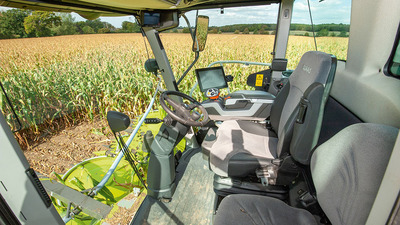
Inside the cab are where the most visual changes can be found. First seen on the firm's Tucano combines in 2018, and this year the new Lexion range, Claas has rolled out its new control concept onto its Jaguar foragers.
This sees a completely new control armrest layout used, along with the introduction of Cebis touch, a new touch screen terminal. For the Jags, this brings with it a whole new load of features and functionality, which should appeal to multiple types of operator. For instance, the way the forager can now be set up can either be done through the screen via touch, through the screen via a rotary dial, by physical adjustment keys, or by using the favourites button on the new Cmotion joystick.
overall control pic
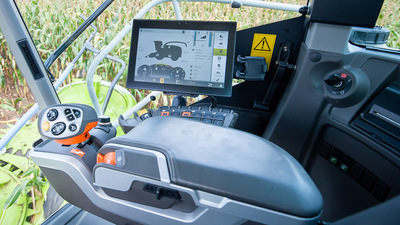
screen pic
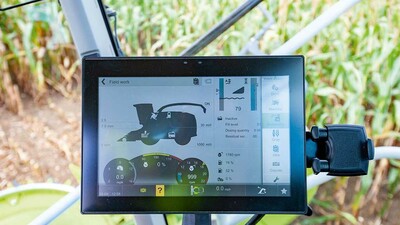
controls copy 2
Controls are well laid out, and the screen can be positioned almost anywhere you like it. As we found, this allows it to be swung completely out of the way to see to the edges of the maize header, or it could be swung forwards when using a grass pickup.
Screen navigation is logical, and clear icons leave you in no doubt as to what all the features and functions do. Even with an adjustment made via a switch, it still pops up on screen to let you know how much adjustment you have made.
Screen information is also customisable, allowing you to tailor what you want to keep an eye on, such as header height and additive dosing rate, for example. Camera images can also be incorporated.
stick pic
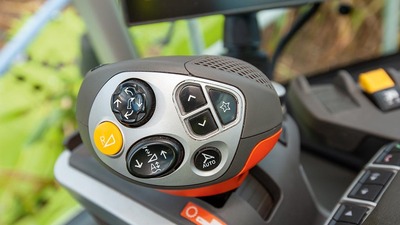
keys pic
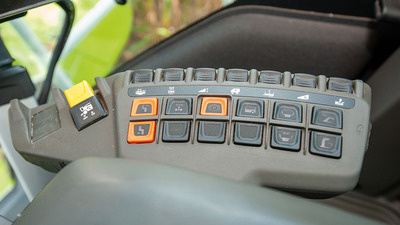
control copy 3
Though we have used the Cmotion lever many times on the firm's tractors, and liked it, it is somewhat of a revelation on the foragers, offering a much improved driving experience. You can also do more with it. However, if it is not your cup of tea, the old style joystick can still be specified as an option.
As mentioned, using the favourites button on the Cmotion lever gives you quick access to functions like roller crop press height, spout height, header tilt and stubble height control. It really is handy.
Cemos automatic
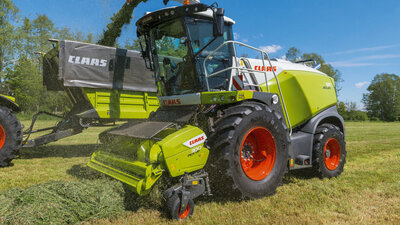
Combining the forager's cruise control and automated power management systems, Claas has developed Cemos Auotomatic. Though not fitted to our test machine, it is said to offer a more consistent output, while trying to reduce fuel consumption.
By setting a target engine speed and a target forward speed, the forager will then try and maintain both by varying its power levels, or if that is not possible it will also vary forward speed to maintain just the engine rpm.
cemos auto 2
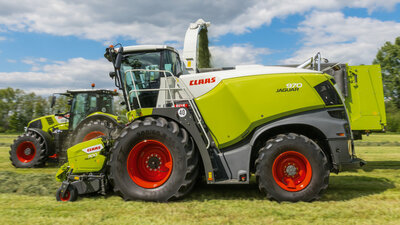
For instance, in a light crop of grass it will mainly be power levels which are varied, with the benefits of both maintaining chop quality and reducing fuel consumption. However, if the crop gets heavier and the forager's power levels are maxed out, it will be the forward speed which is varied to maintain rpm - again to maintain a more uniform chop.
Engine load sensors, along with feed roller opening sensors, determine what power levels and forward speed should be used.
Dynamic steering
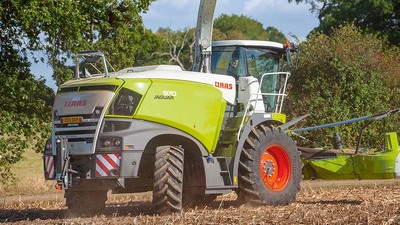
Designed to reduce operator effort, the firm has introduced its Dynamic Steering system.
Normally, it takes about five revolutions of the steering wheel to go from lock to lock - with the system engaged, this reduces to one and a quarter turns.
For safety, as you speed up the number of turns required also gradually increases. And above 20kph the system is switched off and it is back to five turns.
Uprated feeder and cylinder housing
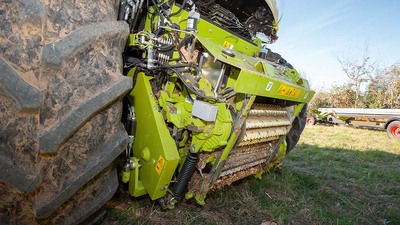
To cope with the extra power and torque of the 900 Series, several key areas of the forager have been beefed up. The feed roller housing for instance features thicker walls, a thicker rear top roller, and uprated bearings and clamps.
Bump stops have also been improved and a cushioning effect incorporated into the hydraulic compression system goes a long way towards boosting the smooth running of the machine, and in theory its longevity.
Movable steel shutters down each side of the housing, also have the desired effect of keeping the forager cleaner.
uprated stuff
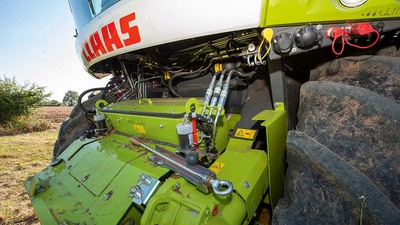
Likewise, around the cylinder housing the sharpening system is better covered and sealed. This has a big effect on noise levels too.
As we found, during a sharpening cycle, you can barely hear the sharpening stone.
To ease maintenance, improved hydraulic couplers means it is now easier to remove the cylinder, says the manufacturer.
Chopping cylinder
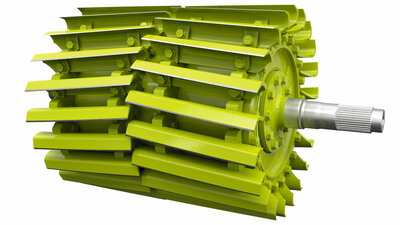
As an option, the firm has also introduced a 42-knive V Max chopping cylinder for the 970, 980 and 990 models, aimed at the biogas market.
Though it creates similar chop lengths, 3.3 to 12.5mm, to the current 36-knife V Max drum it means feed rollers can be run faster. This solves a particular problem in low yielding crops where sometimes forward speed could be too fast for the speed of the feed rollers.
For flexibility, two thirds of the knives can also be removed to create a 14-knife drum, capable of chop lengths from eight to 36.5mm.
Spout gearing

Like the feeder housing, the spout's swivel system has been given a fettle to better cope with increased crop flow. This sees the worm gear swapped for a regular spur gear, driven directly by a hydraulic motor.
As well as providing more turning force, it also reacts a lot quicker. When not moving, the spout is held in place via a disc brake. And should you hit a tree or telegraph pole, a relief valve in the hydraulic system allows the spout to ‘break back'.
Gear wear is also improved, says Claas, with less friction created between the two gears.
Additive dosing and crop sensing
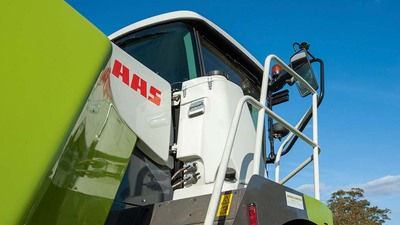
Boosting its low volume additive dosing capacity, the firm has introduced a larger tank, now 37 litres. Clever features include double skin walls which provide much improved insulating properties, better protecting valuable enzymes, and an agitation system which circulates the liquid every five minutes to avoid the settling of power-based additives.
Other sprayer-inspired tech includes a flushing system, supplied by a 20 litre clean water tank which also provides hand washing facilities. Dose rates have also been upped; up to 20l/hour or 50ml/t.
Application rates can also be automated, either determined by the dry matter sensor on the spout, or by the volume meter on the feeder housing.
crop sensing
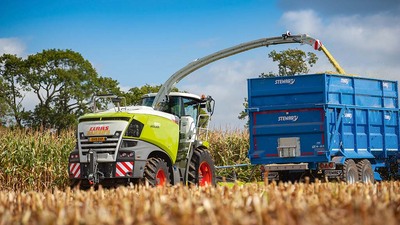
Crop sensing technology has also been given a shot in the arm, via the use of near infrared (NIR) technology which allows the measurement of an increased number of ingredients within the crop, such as starch and protein.
Particularly for AD plants, it allows them to better understand what is going into the digesters, and give an idea of when best to harvest. For livestock farmers, it can be an aid to plan diets, or work out fertiliser/muck application rates, says the manufacturer.
























